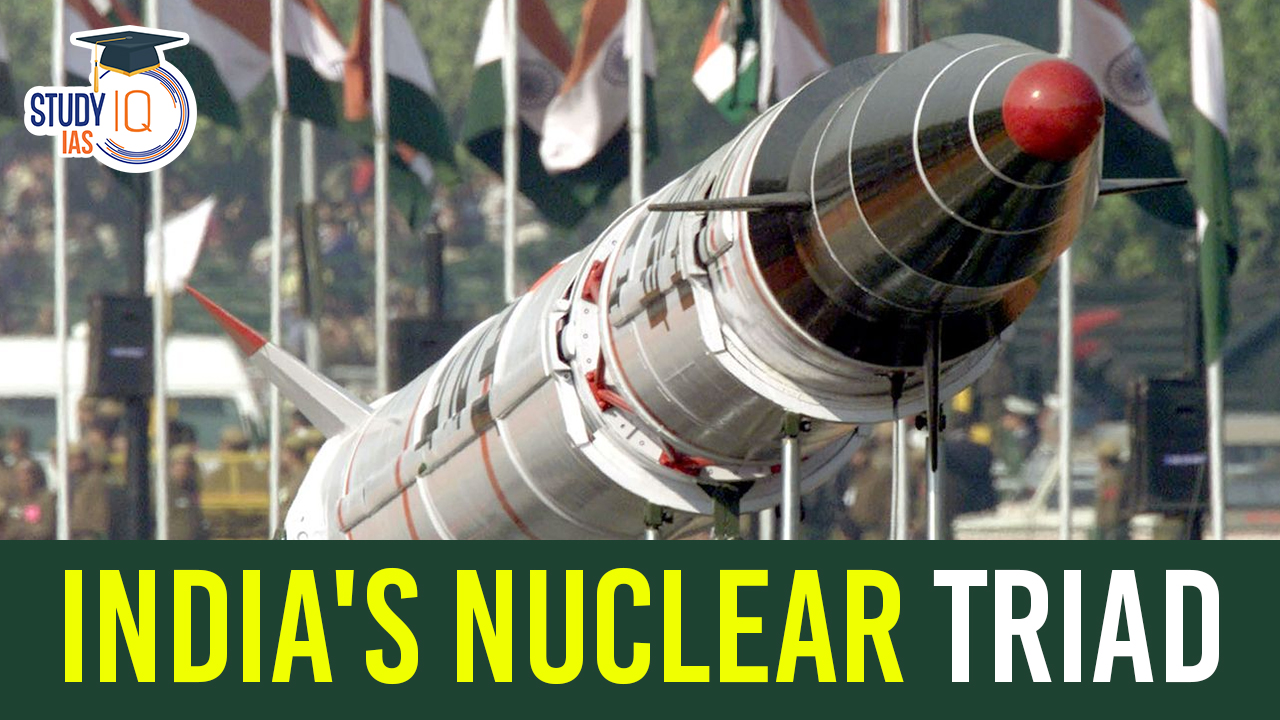Table of Contents
India’s nuclear triad signifies its ability to deploy nuclear weapons via land, air, and sea, making it the sixth nation worldwide with this capability. Components include land-based ballistic missiles like Prithvi and Agni, aircraft such as Rafale, Jaguar, and Sukhoi Su-30, along with submarine-launched missiles K-15 and K-4. India has successfully tested its triad across these domains. Notably, the INS Arihant, a nuclear-powered submarine, embarked on its first deterrence patrol. The exclusive authority to order a nuclear strike rests with the Cabinet Committee on Security (CCS), underlining India’s commitment to a responsible and secure nuclear deterrent.
We’re now on WhatsApp. Click to Join
India’s Nuclear Triad
A “Nuclear Triad” signifies a nation’s capacity to launch nuclear attacks via land, air, and sea. India has successfully demonstrated its capabilities across these domains: Land, through ballistic missiles like the Prithvi and Agni series; Air, using nuclear bombs deployed on Dassault Mirage 2000s and SEPECAT Jaguars in a free-falling, unguided manner; and Sea, with the Sagarika K-15 missile on Arihant-class submarines, and Dhanush missiles fired from vessels like INS Subhadra and INS Rajput.
Land-Based Nuclear Weapons
Agni Missiles: India’s land-based nuclear component relies on its Agni missile series. These ballistic missiles come in various ranges, from short to intercontinental, allowing for precise targeting of adversaries both near and far. Agni’s versatility and range make it a vital part of India’s nuclear deterrence strategy.
Sea-Based Nuclear Weapons
Arihant-Class Submarines: India’s sea-based nuclear capabilities are anchored by the Arihant-class submarines. These ballistic missile submarines (SSBNs) ensure a second-strike capability, even if land-based facilities are compromised. The strategic importance of SSBNs in the nuclear triad cannot be overstated, as they operate silently beneath the ocean’s surface, making them challenging to detect.
Air-Based Nuclear Weapons
Nuclear-Armed Aircraft: India’s air-based component features aircraft like the Mirage 2000 and Su-30MKI, which can be equipped with nuclear warheads. These aircraft serve as a flexible and responsive means of nuclear delivery, providing an additional layer to India’s nuclear triad.
Significance of India’s Nuclear Triad
The significance of India’s nuclear triad, which comprises land, sea, and air-based nuclear delivery systems, is multifaceted and plays a crucial role in the nation’s defense and international relations. Here are some key points highlighting the significance of India’s nuclear triad:
Deterrence Capability
The primary purpose of the nuclear triad is to serve as a powerful deterrent against potential adversaries. The triad’s existence implies that India possesses multiple and diverse means to deliver a nuclear strike, which discourages any hostile actions involving nuclear weapons. This deterrence helps maintain peace and stability in the region.
Survivability
A fundamental benefit of the nuclear triad is its ability to enhance the survivability of India’s nuclear deterrent. Even if one or two components of the triad are compromised in a conflict, the remaining component(s) can still deliver a retaliatory strike. This ensures that India’s nuclear capabilities remain intact even under adverse conditions.
Strategic Stability
India’s nuclear triad contributes to regional and global strategic stability. By having multiple delivery systems, India is less likely to engage in preemptive strikes, promoting a more stable international security environment.
Second-Strike Capability
The triad provides India with a credible second-strike capability, meaning that it can respond to a nuclear attack with a devastating counterstrike. This deters adversaries from launching a first-strike, knowing that India can retaliate effectively.
Global Non-Proliferation Efforts
India’s responsible and credible nuclear posture, including its No First Use (NFU) policy, adds to international non-proliferation efforts. India’s commitment to using nuclear weapons only for retaliation sets a positive example for other nuclear-armed states and contributes to global security.
National Sovereignty
Possessing a nuclear triad enhances India’s sovereignty and national security. It provides the country with a greater degree of self-reliance and ensures that its security is not overly dependent on any one type of delivery system.
Global Influence
India’s status as a nuclear triad power enhances its position in international diplomacy and negotiations. It gives India a stronger voice on matters related to nuclear disarmament, arms control, and regional security.
Modernization and Technological Advancements
The pursuit of a nuclear triad has driven India to invest in research, development, and modernization of its defense infrastructure. This, in turn, fosters technological advancements in various sectors, benefiting the nation’s overall security and scientific capabilities.
India’s Nuclear Triad UPSC
India’s nuclear triad, encompassing land, sea, and air-based nuclear delivery systems, is of immense significance. It serves as a potent deterrent, dissuading potential adversaries from nuclear aggression and maintaining regional stability. The triad’s diversification ensures the survivability of India’s nuclear arsenal, even in the face of a first-strike. With a credible second-strike capability, India can respond effectively to a nuclear attack, deterring preemptive strikes. Its responsible nuclear posture, including the No First Use (NFU) policy, bolsters global non-proliferation efforts, while enhancing sovereignty, and global influence, and fostering modernization and technological advancements. India’s nuclear triad is pivotal for national security and international diplomacy.


 AI and its Regulation in India, Limitati...
AI and its Regulation in India, Limitati...
 Tuberculosis (TB), Symptoms, Causes and ...
Tuberculosis (TB), Symptoms, Causes and ...
 Silicon Photonics Enables Low-power AI A...
Silicon Photonics Enables Low-power AI A...





















